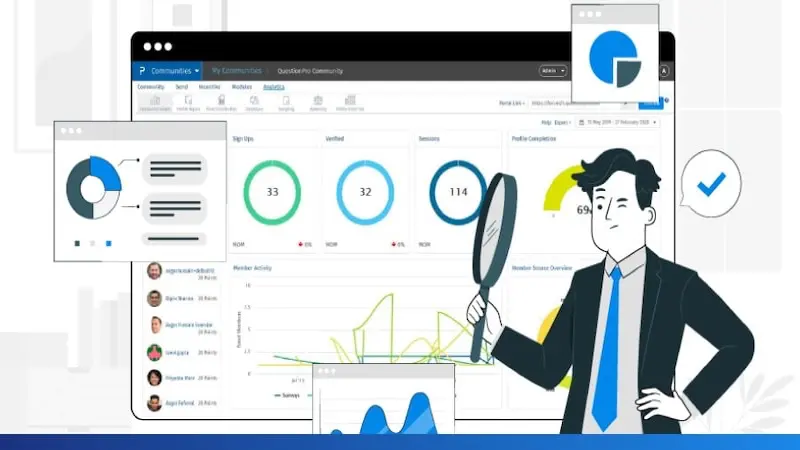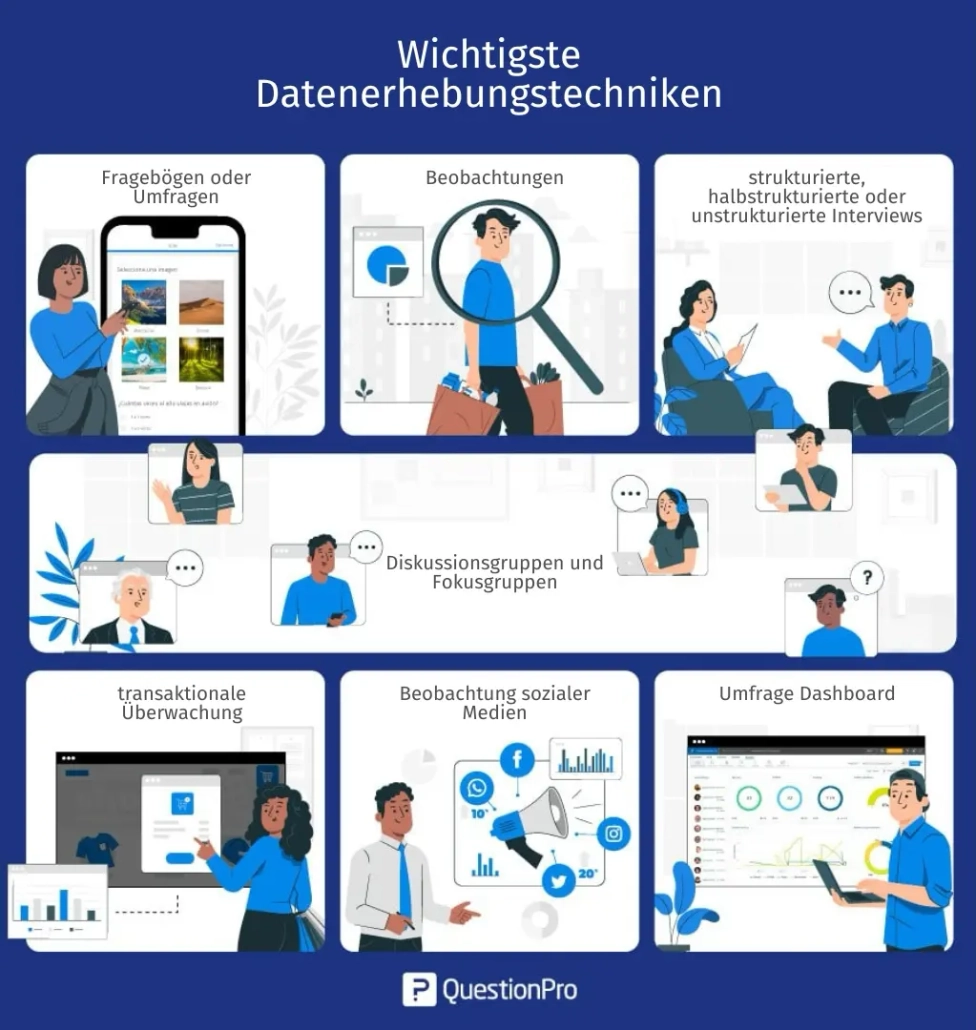Market research
In each research area, the choice is the most appropriate Data collection techniques fundamental to achieving the aim and purpose of a research project.
Regardless of whether you are conducting a bachelor's or master's thesis or are part of a team in an organization, you must be clear about the concept and the different data collection techniques.
That's why in this article we have put together some of the most important techniques for market and social research.
CONTENT
- 1 What are data collection techniques?
- 2 Importance of using data collection techniques
- 3 The 8 most important data collection techniques
- 4 How to choose the right data collection techniques?
- 5 How to use data collection techniques effectively?
- 6 Conclusion
- 7 1:1 Live Online Presentation: QUESTIONPRO MARKET RESEARCH SOFTWARE
- 8 Try software for market research and experience management now for 10 days free of charge!
What are data collection techniques?
Data collection techniques are a range of different tools that allow information to be collected skillfully and effectively for research and analysis purposes.
Research projects often combine multiple data collection techniques to ensure the validity and reliability of an investigation.
Using multiple data collection techniques and sources increases the credibility of the results and allows different interpretations and meanings to be incorporated into the analysis of the data.
The term “data collection techniques” is often used to refer to both data collection methods and the various techniques that are part of them.
Importance of using data collection techniques
Evaluating the available techniques and their relevance to the research objective is one of the most important steps in data collection.
Choosing the most appropriate data collection techniques is crucial to maintaining the integrity of the research, regardless of the topic of the study or the preferred research method for defining the data (quantitative, qualitative).
The likelihood of errors is reduced when appropriate data collection techniques (whether new, updated versions of the same or existing ones) are used.
The 8 most important data collection techniques
There are a variety of data collection techniques you can use as part of your research methodology. Techniques that stand out in both social research and market research include the following:
Questionnaires or surveys
Questionnaires are one of the most commonly used data collection techniques as they can be conducted both physically and digitally to collect quantitative data through surveys and qualitative data through interviews and qualitative surveys.
Questionnaires are a fundamental part of surveys and because they are inexpensive to create and answer, they represent a very accessible option for both researchers and their correspondents or field survey officers.
Questionnaires are generally used to collect responses about an event or topic. The collected answers can be used as a basis for product improvements, decision matrices or further studies.
Observations
The simplest and most straightforward data collection techniques are based on observation:
- Qualitative observation or quantitative observation.
- Participant or non-participant observation.
The most common form of observation in data collection is simply observing the behavior or actions of a subject in a particular environment in order to understand and record what is observed.
In today's online world, an example of such observation can be watching people interact with products, websites, and services in real time.
Structured, semi-structured or unstructured survey
An interview is precisely defined as a formal meeting between two people in which the interviewer asks questions of the respondent to gather information. There are different types of interviews:
- Structured interview: A structured interview consists of a questionnaire with a specially developed logic that must be answered in a specific way.
- Semi-structured: A data collection technique that uses a series of leading questions to guide the topic of conversation, but are not necessarily answered to the letter.
- Unstructured: This is a type of interview that does not use a questionnaire or question guide, but rather attempts to have an impromptu conversation on the desired topic. It is typically used in exploratory research to identify topics that may be important to subjects without being influenced by research theories.
Focus groups and focus groups
Another data collection technique is the use of focus groups, which attempt to create a situation that reflects the social context in which people's perspectives and opinions develop.
A focus group is a form of conversation similar to an interview that takes place in a group of six to twelve people who share a common interest, characteristic or need.
Focus group techniques can be group interviews, focus groups, expert groups, Delphi groups, online focus groups, etc.
Transaction tracking
Transaction tracking is a data collection technique that relies on purchases made to obtain information.
With every purchase a customer makes, researchers and marketers can access data from their websites, from a third-party service provider, or from their in-store e-commerce POS system.
From there, they can track different forms and amounts of data that allow them to develop better marketing plans and products and target ideal customers.
Social media monitoring
Social listening or social media monitoring is a similar data collection technique to transaction tracking.
However, instead of a customer's transaction history, this technique focuses on tracking their social media history and footprint.
Many platforms and companies use this technique to track users' engagement with various online posts and better understand what products and services interest them and what they consider important.
Survey dashboard
A survey dashboard can provide statistics on response rate, completion rate, demographic filters, export and sharing options, etc.
Once the data is collected, the survey software can generate different types of reports and run analytical algorithms to uncover hidden information.
Text or content analysis
Text or content analysis is a collection and analysis technique that is used as part of secondary data collection methods.
You can use this technique to examine changes in official, institutional or organizational views on a particular topic or area, to document the context of certain practices, or to examine the experiences and perspectives of a group of people who have participated in a written reflection, for example.
The research question will guide the development of a coding table or scheme for analysis that will be iteratively applied to the selected documents.
How to choose the right data collection techniques?
To choose the most appropriate data collection techniques, we recommend you:
- Consider the research goal: Which methods seem best suited to your research goal and the questions you want to answer?
- Consider stakeholders: Use a technique that allows you to collect information that can be analysed and presented in a way that stakeholders find credible.
- Think about the study participants from whom you want to collect data: Where and how can participants best be reached? Which method is culturally and linguistically best suited? Is an in-person interview or a survey more suitable for certain target groups? Does the data already exist, in program data systems or public institutions?
- Consider the resources available: Think about what techniques you can afford to carry out in a timely manner. Consider when the results will be needed, your own capacity, the cost of hiring external staff, and other resource issues.
- Consider the advantages and disadvantages of each procedure: What are the main strengths and weaknesses of each procedure? Evaluate aspects such as time and participant effort, costs, infrastructure required and access to records. Which method is best for your research needs?
How to use data collection techniques effectively?
Once you have decided on the right data collection technique for your study, you should consider the following aspects to ensure its correct application:
1. Assess the data you need to collect.
It's all too easy to get information about anything, but it's important to gather only the information we need. To do this, it makes sense to ask yourself these 3 questions:
- What information will actually be useful?
- What data do we have available?
- What specific details are needed?
2. Plan appropriate data collection techniques.
To choose the right data collection techniques, you need to consider the type of information you want to collect, the time frame in which you want to collect it, and the other key aspects of the research you have determined.
Consider the time and difficulty involved in collecting each piece of data when deciding which technique to use.
3. Consider identifiers
Identifiers, or details that describe the context and source of a survey response, are just as important as the information about the topic or program you are researching.
In general, adding more identifiers allows us to more accurately determine our program's successes and failures, but it is important to proceed in moderation.
4. Classify each type of data into a special field.
It is possible to mix data types in data entry fields. Both the code and the comment can be informative, but should be placed in separate data entry fields (with data validation where appropriate).
5. Use data validation
When using text fields, use validation types and set minimum and/or maximum values when possible to improve data accuracy.
Always use data validation, especially for known formats of a field; for example, dates and email addresses should be validated during data entry.
Conclusion
In this article, we've introduced you to some of the most commonly used data collection techniques in market and social research, but there are also tools you can use to implement them successfully.
QuestionPro is a platform with a range of tools that you can use to make the most of your chosen research techniques, particularly online surveys, surveys in remote locations without internet access and online focus groups.
Get to know them first-hand by creating a free account or taking advantage of a free trial of our Advanced License, which offers unique features for all your research needs.
1:1 live online presentation:
QUESTIONPRO MARKET RESEARCH SOFTWARE
Arrange an individual appointment and discover our market research software.
Try software for market research and experience management now for 10 days free of charge!
Do you have any questions about the content of this blog? Simply contact us via contact form. We look forward to a dialogue with you! You too can test QuestionPro for 10 days free of charge and without risk in depth!
Test the agile market research and experience management platform for qualitative and quantitative data collection and data analysis from QuestionPro for 10 days free of charge
FURTHER KEYWORDS
SHARE THIS ARTICLE
KEYWORDS OF THIS BLOG POST
Data collection techniques | data collection | Techniken
FURTHER INFORMATION
- Data virtualization: what it is, advantages and benefits
- Synthetic data: what they are, types, methods and uses
- Observational data: what it is, types and use cases
- Numerical data: what are they, characteristics, types and examples
- Hard and soft data: what they are and how they differ
- Data filtering: what it is, benefits and examples
- Data collection tools: which are the best?
- Big Data and Artificial Intelligence: How do they work together?




